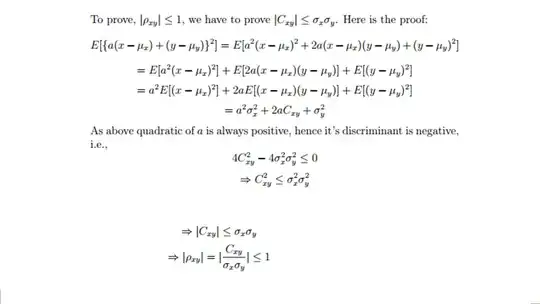- A quadratic expression $f(x) = ax^2 + bx + c$ that is always positive cannot have any real roots. The graph of $y = f(x)$ is a parabola, and $f(x) > 0$ means it lies entirely above the $x$-axis. Thus, it never intersects or touches the $x$-axis, which means it has no real roots. This is so only when the discriminant is negative. In the case where $f(x) \ge 0$, there can be at most one real root (where the parabola touches the $x$-axis), so the discriminant can be $0$ or negative.
- This is an indirect method of proof.
In the spirit of simplicity, here is a rewriting of the same proof:
Let $X$ and $Y$ be two random variables, and let $a$ be a positive real number. Now, $aX + Y$ is a random variable, so its variance $V(aX + Y) \ge 0$ (variance is always non-negative). Using the properties of variance:
$V(aX + Y) \ge 0\Rightarrow\\
a^2V(X) + 2a\text{Cov}(X, Y) + V(Y^2) \ge 0$
Now, as the LHS is a quadratic function of $a$ that is always non-negative, its graph is a parabola that lies entirely above the $x$-axis. Thus, it either has complex roots, or has at most one real root, which implies that the discriminant is non-positive:
$[2\text{Cov}(X, Y)]^2 - 4a^2V(X)V(Y) \le 0 \Rightarrow\\
[\text{Cov}(X, Y)]^2 \le V(X)V(Y) \Rightarrow\\
\left[\dfrac{\text{Cov}(X, Y)}{V(X)V(Y)}\right]^2 \le 1 \Rightarrow\\
\rho^2 \le 1 \Rightarrow\\
-1 \le \rho \le 1$
